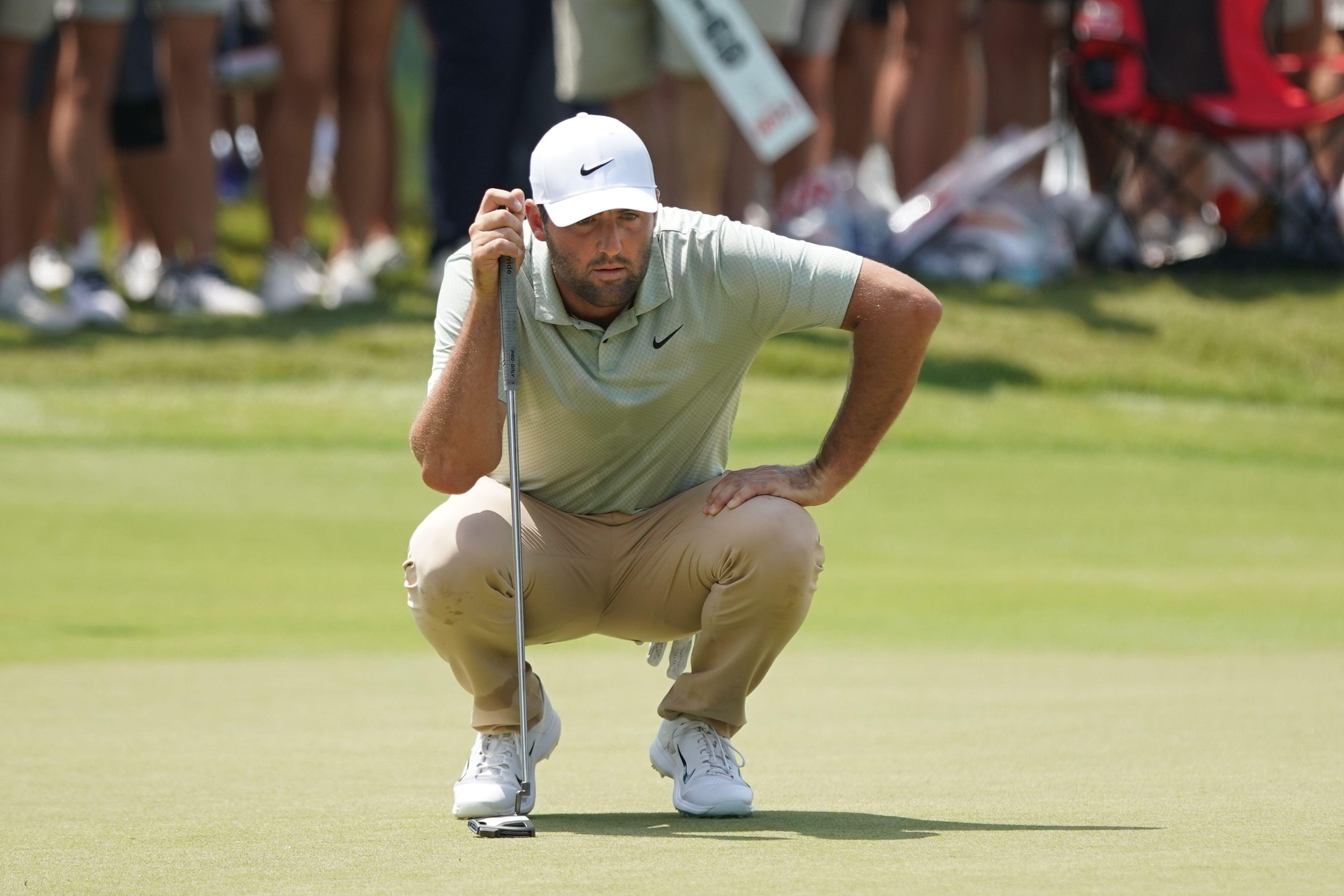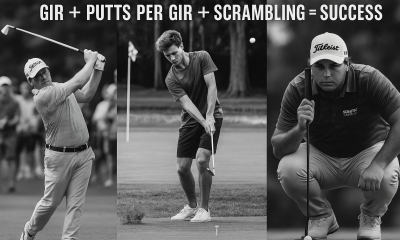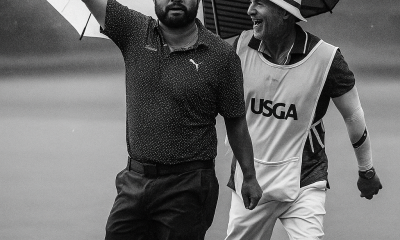Instruction
How to master the art of putting

Golf is a multifaceted sport, with numerous aspects requiring attention to play at your best; from the intricacies of the driver to the fairway woods and hybrids, the irons to the wedges, and the variety of shots you can hit with all of these. Then there is putting, which many golfers and coaches feel is the cornerstone of the game — it’s the game within the game and any area where strokes can be saved or squandered.
In putting, the path of the stroke and how the face of the putter head is situated in relation to that path are critical components that determine the accuracy and consistency of your putts. I want to dive into these two areas with you today to help you better understand these crucial aspects and explore drills to help you hone your skills.
Understanding the Importance of Path and Face
The path refers to the direction your putter travels during the stroke. A consistent and controlled path ensures that your putts travel straight down the intended line. In conjunction with the path of the stroke, the putter’s face should be square to this path at impact. A misalignment in either can lead to a missed putt.
Think of the face and path relationship as driving a car: if your steering (path) and wheels (face) aren’t aligned with the road, you’ll veer off course. Similarly, when putting, maintaining an aligned path and face will guide your ball accurately toward the hole.
Drill 1: The Gate Drill
The Gate Drill is a classic, and it really helps with working on face control and the path of your stroke through impact.
Here is what you do:
Set up two tees slightly wider than your putter head, approximately six inches in front of the ball. Your aim is to roll the ball through this gate without hitting the tees. This drill helps ensure your path is consistent and your face is square at impact. Practicing this will develop muscle memory for the correct stroke essence.

In a variation of the gate drill, my student Kathryn is working here on a square face at impact and spot-putting to an additional gate at the putt’s apex point.
How to Hold The Putter: Let Me Count The Ways…
Gripping the putter is all about finding what best enables you to square the putter face at impact. Different golfers swear by various methods; some prefer the lead-hand-low method, which promotes better shoulder alignment, while others, like Scottie Scheffler this past week at the Hero, opted for the claw style typically used for finding better touch and feel. Regardless of what you choose to use, it’s really all about personal preference—experiment until you discover the grip that offers you the most consistent squared face.

Staying Steady: The Body’s Role
To maintain control during your putting stroke, it’s crucial to remain as still as possible. Unnecessary body movement can lead to an errant putt. Focus on quieting your lower body and maintaining a steady head position—small but significant adjustments that pay substantial dividends on the green.
Drill 2: The Mirror Drill
A putting mirror is an invaluable training aid for aligning your eyes over the ball and maintaining a steady head position. Place it on the practice green and position yourself so you can see both your eyes and the putter in the reflection. Maintain this steady position throughout your stroke. This drill helps avert any body movement that could throw off your aim—as steadiness breeds consistency.
The Strategy of Spot Putting
Beyond the mechanics and set-up basics discussed above, I wanted to touch on one more aspect to help you putt your best. Spot putting is the concept of visualizing the putt’s line and identifying a spot, often at the apex of the break, where you need the ball to travel. This method provides a visual target that helps you lock in before making your stroke. In most cases, the hole should not be your focus, as putts are rarely perfectly straight.
When working with my students, I emphasize the importance of determining where they perceive the apex of the break to be and guide them to putt to that target. This focus encourages confident strokes as opposed to mechanical thinking, which is what most golfers should be doing in the first place.

Tiger Woods and Charlie Woods finding their putt’s line during the Final Round of the PNC Championship in 2023 at the Ritz-Carlton Golf Club in Orlando, Florida. Darren Lee/CSM/Alamy Live News
Final Thoughts
When you’re on the putting green, remember the fundamentals:
- A balanced path and face alignment.
- A grip that allows you to deliver a square clubface into the ball.
- Limited body movement.
- A well-chosen target spot on your line.
By incorporating these aspects and drills into your routine, you will be well on your way to mastering putting precision. Keep practicing, stay focused, and watch as your scores start to reflect your improved game.
Reader, please support me by checking out my three weekly columns on RG. On Mondays, I present “The Starter,” which recaps the week gone by in golf. On Wednesdays, I give you “Fairway Focus,” which previews the week to come in golf. And on Fridays, I dish up the “Friday Fore-cast,” a look at what’s on tap for the upcoming weekend.
Editor’s note: Tuesday Tips will be an ongoing series in which Brendon shares his nearly 30 years of experience in the game with GolfWRX readers. He looks forward to providing valuable insights and advice to help golfers improve their game. Stay tuned for more Tuesday Tips!
Instruction
The Wedge Guy: Beating the yips into submission

There may be no more painful affliction in golf than the “yips” – those uncontrollable and maddening little nervous twitches that prevent you from making a decent stroke on short putts. If you’ve never had them, consider yourself very fortunate (or possibly just very young). But I can assure you that when your most treacherous and feared golf shot is not the 195 yard approach over water with a quartering headwind…not the extra tight fairway with water left and sand right…not the soft bunker shot to a downhill pin with water on the other side…No, when your most feared shot is the remaining 2- 4-foot putt after hitting a great approach, recovery or lag putt, it makes the game almost painful.
And I’ve been fighting the yips (again) for a while now. It’s a recurring nightmare that has haunted me most of my adult life. I even had the yips when I was in my 20s, but I’ve beat them into submission off and on most of my adult life. But just recently, that nasty virus came to life once again. My lag putting has been very good, but when I get over one of those “you should make this” length putts, the entire nervous system seems to go haywire. I make great practice strokes, and then the most pitiful short-stroke or jab at the ball you can imagine. Sheesh.
But I’m a traditionalist, and do not look toward the long putter, belly putter, cross-hand, claw or other variation as the solution. My approach is to beat those damn yips into submission some other way. Here’s what I’m doing that is working pretty well, and I offer it to all of you who might have a similar affliction on the greens.
When you are over a short putt, forget the practice strokes…you want your natural eye-hand coordination to be unhindered by mechanics. Address your putt and take a good look at the hole, and back to the putter to ensure good alignment. Lighten your right hand grip on the putter and make sure that only the fingertips are in contact with the grip, to prevent you from getting to tight.
Then, take a long, long look at the hole to fill your entire mind and senses with the target. When you bring your head/eyes back to the ball, try to make a smooth, immediate move right into your backstroke — not even a second pause — and then let your hands and putter track right back together right back to where you were looking — the HOLE! Seeing the putter make contact with the ball, preferably even the forward edge of the ball – the side near the hole.
For me, this is working, but I am asking all of you to chime in with your own “home remedies” for the most aggravating and senseless of all golf maladies. It never hurts to have more to fall back on!
Instruction
Looking for a good golf instructor? Use this checklist

Over the last couple of decades, golf has become much more science-based. We measure swing speed, smash factor, angle of attack, strokes gained, and many other metrics that can really help golfers improve. But I often wonder if the advancement of golf’s “hard” sciences comes at the expense of the “soft” sciences.
Take, for example, golf instruction. Good golf instruction requires understanding swing mechanics and ball flight. But let’s take that as a given for PGA instructors. The other factors that make an instructor effective can be evaluated by social science, rather than launch monitors.
If you are a recreational golfer looking for a golf instructor, here are my top three points to consider.
1. Cultural mindset
What is “cultural mindset? To social scientists, it means whether a culture of genius or a culture of learning exists. In a golf instruction context, that may mean whether the teacher communicates a message that golf ability is something innate (you either have it or you don’t), or whether golf ability is something that can be learned. You want the latter!
It may sound obvious to suggest that you find a golf instructor who thinks you can improve, but my research suggests that it isn’t a given. In a large sample study of golf instructors, I found that when it came to recreational golfers, there was a wide range of belief systems. Some instructors strongly believed recreational golfers could improve through lessons. while others strongly believed they could not. And those beliefs manifested in the instructor’s feedback given to a student and the culture created for players.
2. Coping and self-modeling can beat role-modeling
Swing analysis technology is often preloaded with swings of PGA and LPGA Tour players. The swings of elite players are intended to be used for comparative purposes with golfers taking lessons. What social science tells us is that for novice and non-expert golfers, comparing swings to tour professionals can have the opposite effect of that intended. If you fit into the novice or non-expert category of golfer, you will learn more and be more motivated to change if you see yourself making a ‘better’ swing (self-modeling) or seeing your swing compared to a similar other (a coping model). Stay away from instructors who want to compare your swing with that of a tour player.
3. Learning theory basics
It is not a sexy selling point, but learning is a process, and that process is incremental – particularly for recreational adult players. Social science helps us understand this element of golf instruction. A good instructor will take learning slowly. He or she will give you just about enough information that challenges you, but is still manageable. The artful instructor will take time to decide what that one or two learning points are before jumping in to make full-scale swing changes. If the instructor moves too fast, you will probably leave the lesson with an arm’s length of swing thoughts and not really know which to focus on.
As an instructor, I develop a priority list of changes I want to make in a player’s technique. We then patiently and gradually work through that list. Beware of instructors who give you more than you can chew.
So if you are in the market for golf instruction, I encourage you to look beyond the X’s and O’s to find the right match!
Instruction
What Lottie Woad’s stunning debut win teaches every golfer

Most pros take months, even years, to win their first tournament. Lottie Woad needed exactly four days.
The 21-year-old from Surrey shot 21-under 267 at Dundonald Links to win the ISPS Handa Women’s Scottish Open by three shots — in her very first event as a professional. She’s only the third player in LPGA history to accomplish this feat, joining Rose Zhang (2023) and Beverly Hanson (1951).
But here’s what caught my attention as a coach: Woad didn’t win through miraculous putting or bombing 300-yard drives. She won through relentless precision and unshakeable composure. After watching her performance unfold, I’m convinced every golfer — from weekend warriors to scratch players — can steal pages from her playbook.
Precision Beats Power (And It’s Not Even Close)
Forget the driving contests. Woad proved that finding greens matters more than finding distance.
What Woad did:
• Hit it straight, hit it solid, give yourself chances
• Aimed for the fat parts of greens instead of chasing pins
• Let her putting do the talking after hitting safe targets
• As she said, “Everyone was chasing me today, and managed to maintain the lead and played really nicely down the stretch and hit a lot of good shots”
Why most golfers mess this up:
• They see a pin tucked behind a bunker and grab one more club to “go right at it”
• Distance becomes more important than accuracy
• They try to be heroic instead of smart
ACTION ITEM: For your next 10 rounds, aim for the center of every green regardless of pin position. Track your greens in regulation and watch your scores drop before your swing changes.
The Putter That Stayed Cool Under Fire
Woad started the final round two shots clear and immediately applied pressure with birdies at the 2nd and 3rd holes. When South Korea’s Hyo Joo Kim mounted a charge and reached 20-under with a birdie at the 14th, Woad didn’t panic.
How she responded to pressure:
• Fired back with consecutive birdies at the 13th and 14th
• Watched Kim stumble with back-to-back bogeys
• Capped it with her fifth birdie of the day at the par-5 18th
• Stayed patient when others pressed, pressed when others cracked
What amateurs do wrong:
• Get conservative when they should be aggressive
• Try to force magic when steady play would win
• Panic when someone else makes a move
ACTION ITEM: Practice your 3-6 foot putts for 15 minutes after every range session. Woad’s putting wasn’t spectacular—it was reliable. Make the putts you should make.
Course Management 101: Play Your Game, Not the Course’s Game
Woad admitted she couldn’t see many scoreboards during the final round, but it didn’t matter. She stuck to her game plan regardless of what others were doing.
Her mental approach:
• Focused on her process, not the competition
• Drew on past pressure situations (Augusta National Women’s Amateur win)
• As she said, “That was the biggest tournament I played in at the time and was kind of my big win. So definitely felt the pressure of it more there, and I felt like all those experiences helped me with this”
Her physical execution:
• 270-yard drives (nothing flashy)
• Methodical iron play
• Steady putting
• Everything effective, nothing spectacular
ACTION ITEM: Create a yardage book for your home course. Know your distances to every pin, every hazard, every landing area. Stick to your plan no matter what your playing partners are doing.
Mental Toughness Isn’t Born, It’s Built
The most impressive part of Woad’s win? She genuinely didn’t expect it: “I definitely wasn’t expecting to win my first event as a pro, but I knew I was playing well, and I was hoping to contend.”
Her winning mindset:
• Didn’t put winning pressure on herself
• Focused on playing well and contending
• Made winning a byproduct of a good process
• Built confidence through recent experiences:
- Won the Women’s Irish Open as an amateur
- Missed a playoff by one shot at the Evian Championship
- Each experience prepared her for the next
What this means for you:
• Stop trying to shoot career rounds every time you tee up
• Focus on executing your pre-shot routine
• Commit to every shot
• Stay present in the moment
ACTION ITEM: Before each round, set process goals instead of score goals. Example: “I will take three practice swings before every shot” or “I will pick a specific target for every shot.” Let your score be the result, not the focus.
The Real Lesson
Woad collected $300,000 for her first professional victory, but the real prize was proving that fundamentals still work at golf’s highest level. She didn’t reinvent the game — she simply executed the basics better than everyone else that week.
The fundamentals that won:
• Hit more fairways
• Find more greens
• Make the putts you should make
• Stay patient under pressure
That’s something every golfer can do, regardless of handicap. Lottie Woad just showed us it’s still the winning formula.
FINAL ACTION ITEM: Pick one of the four action items above and commit to it for the next month. Master one fundamental before moving to the next. That’s how champions are built.
PGA Professional Brendon Elliott is an award-winning coach and golf writer. You can check out his writing work and learn more about him by visiting BEAGOLFER.golf and OneMoreRollGolf.com. Also, check out “The Starter” on RG.org each Monday.
Editor’s note: Brendon shares his nearly 30 years of experience in the game with GolfWRX readers through his ongoing tip series. He looks forward to providing valuable insights and advice to help golfers improve their game. Stay tuned for more Tips!





















